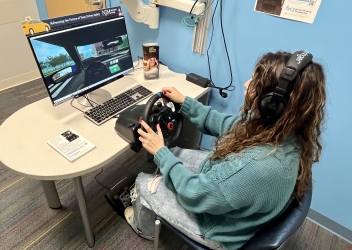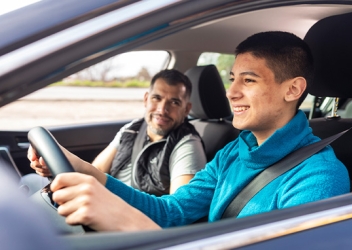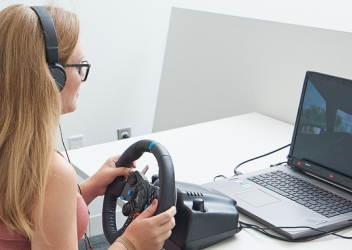Driver Licensing and Training
The ability to access quality driver education and training in order to drive safely when licensed is both a young driver safety and transportation equity issue. Researchers at the Center for Injury Research and Prevention at Children's Hospital of Philadelphia are collaborating with researchers from the University of Pennsylvania's Annenberg Public Policy Center and Weitzman School of Design to improve driver licensing and training.
Driver Licensing and Training Research Projects
- Driver Education Research (DRIVER) Study
This study is investigating the effectiveness of different types of driver training interventions for reducing young new driver crash risk early after licensure (when crash risk is highest). This contemporary look at driver training is a three-arm randomized controlled trial in which about 1,000 participants with an active PA learner’s permit will be enrolled and followed from first virtual driving assessment at CHOP, throughout the learner permit period, at the point of the license examination, and for 6 months after receiving their license. They will be randomized into one of three interventions during the learner permit period: 1) behind-the-wheel training with a local driving school instructor; 2) online driver training, or 3) care-as-usual plus online education.
Principal Investigators: Elizabeth Walshe, PhD; Daniel Romer, PhD; Flaura Winston, MD, PhD
Funding: Eunice Kennedy Shriver National Institute for Child Health and Human Development
- Adult-Supervised Practice In Learner's Permit Phase Has Significant But Limited Ability to Improve Safe Driving Skills
A team of researchers from the Stuart Weitzman School of Design at the University of Pennsylvania and the Center for Injury Research and Prevention at Children's Hospital of Philadelphia examined the relationship between the number of adult-supervised practice hours and driving performance and skill deficits for 441 learner permit holders ages 16 and 17 in Pennsylvania. The findings suggest that longer practice hours have limited associations with improvements in how learner drivers are classified in a virtual driving assessment (Major Issues, Major Issues with Dangerous Behavior, Minor Issues, No Issues). This may be because some adolescents may not be ready to handle the more dangerous settings the assessment presents even after completing the required hours of adult-supervised practice.
Read the abstract.
Principal Investigators: Xiaoxia Dong, PhD, Jasmine Wu
Funding: NJM Insurance Group
- Variation in Young Driver Training Requirements by State
A team of researchers from the University of Pennsylvania and Children's Hospital of Philadelphia published a research letter in JAMA Network Open that shares information on US states that do not require sufficient preparation before allowing young drivers on the road. They conducted a contemporary review of license policies across all 50 states from May-August 2022 to determine behind-the-wheel (BTW) and adult supervised practice (ASP) requirements prior to intermediate licensure for those under 18 and whether these mandates are truly required (or can be replaced).
They then created state-by-state flow diagrams for the process and requirements/exceptions for licensure, with particular attention to those under age 18 (the group most commonly subject to Graduated Driver Licensing laws). States were categorized by BTW and ASP requirements prior to licensure.
They found that most states (28) require both professional training and adult-supervised practice. However, 19 states have no or minimal training requirements, 7 of which have no BTW or ASP requirements. Three additional states encourage training but allow replacement with ASP. The authors also highlight in the discussion that BTW requirements may favor those with access to and sufficient finances for BTW, potentially creating transportation equity issues in the ability to gain a license and drive legally.
Read a blog post about the research.
Principal Investigators: Elizabeth Walshe, PhD; Daniel Romer, PhD
Funding: National Institutes of Health
- Identifying Community-Level Disparities in Access to Driver Education and Training: Toward a Definition of Driver Training Deserts
There are critical needs for gaining mobility from automobile in the US. Although behind-the-wheel (BTW) driving instruction is required in 28 states to secure a license before age 18, some teens find obtaining a license challenging with this requirement due to where they live and their economic situation. A team of researchers from the Stuart Weitzman School of Design at the University of Pennsylvania and the Center for Injury Research and Prevention at Children’s Hospital of Philadelphia investigated accessibility to driver training at different scales and its impacts to define Driver Training Deserts, geographic areas of disconnection to driver training.
What they found is that economic standing explains the propensity to take BTW instruction much more than the distance to driver training schools does. Future research is needed to correlate Driver Training Deserts with licensure rates, enrollment in driver training, and safe driving outcomes to understand if they can help explain transportation equity outcomes related to young driver safety.
Read the abstract.
Principal Investigators: Meghan S, Ryerson, PhD; Joshua Davidson; Jasmine Siyu Wu; Ilil Feiglin; Flaura Winston, MD, PhD
Funding: US National Highway Traffic Safety Administration through the Ohio Traffic
Safety Office; State of Ohio’s Department of Administrative Services;
Ohio Bureau of Motor Vehicles- Financial Status and Travel Time to Driving Schools As Barriers to Obtaining a Young Driver License in a State with Comprehensive Young Driver Licensing Policy
A team of researchers from the Stuart Weitzman School of Design at the University of Pennsylvania and Children's Hospital of Philadelphia investigated the presence of barriers to accessing driver training and licensure, particularly among low-income teens. Utilizing a database from the Ohio Bureau of Motor Vehicles, which included over 35,000 applicants aged 15.5 to 25 years old, the study employed logit models to estimate the likelihood of young drivers completing driver training and obtaining a license before age 18 based on their socioeconomic backgrounds and travel time to driving schools. Ohio requires comprehensive driver training, including behind-the-wheel training (BTW) and Graduated Driver Licensing restrictions, to get licensed before age 18.
Their findings, published in Accident Analysis & Prevention, revealed that financial status and travel time significantly impacted the likelihood of teenagers completing driver training and obtaining a young driver's license. Specifically, young drivers in lower-income Census tracts had a lower probability of completing driver training and obtaining a license before age 18. Conversely, as travel time to driving schools increased, teenagers from wealthier Census tracts were more likely to forgo driver training and licensure compared to their counterparts in lower-income areas.
Read a press release about the research.
Principal Investigators: Flaura Winston, MD, PhD; Megan Ryerson, PhD
Funding: US National Highway Traffic Safety Administration (NHTSA) through the Ohio Traffic Safety Office (OTSO) and by the Ohio Bureau of Motor Vehicles
- Residing in a Driver Training Desert Leads to Delayed Licensure: Investigating the Relationship Between Accessibility to Driver Training and Young Driver’s Licensure
Access to formal driver education and training with professional instructors (DT) is both a safety and a mobility equity issue for teens in the U.S. It remains unclear whether teens living in neighborhoods with lower socioeconomic status and poorer access to driver training, known as Driver Training Deserts, have lower probabilities of taking training and securing a young driver’s license.
A team of researchers from the Stuart Weitzman School of Design at the University of Pennsylvania and the Center for Injury Research and Prevention at Children's Hospital of Philadelphia used a teen driver dataset from Columbus, OH MSA, to determine whether driver education training leads to safer outcomes and whether unlicensed teens may have greater difficulty accessing certain educational and employment opportunities than their peers who are able to drive.
What they found is that on average, teens living in Driver Training Deserts have lower probabilities of DT and licensure before age 18. The findings are helping local authorities in Columbus, OH prioritize geographic areas for their financial assistance pilot program that aims to improve access to DT and licensure for lower-income teens. The findings also highlight the need for qualitative studies to understand barriers to accessing driver training services.
Read a press release about the research.
Read the abstract.
Principal Investigators: Xiaoxia Dong, PhD; Flaura Winston, MD, PhD; Meghan S, Ryerson, PhD
Funding: US National Highway Traffic Safety Administration (NHTSA) through the Ohio Traffic Safety Office (OTSO); State of Ohio’s Department of Administrative Services;
Ohio Bureau of Motor Vehicles









